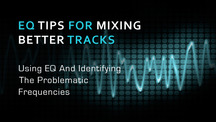A producer always has 99 problems to look out for. This post looks at EQ tips for mixing better tracks. More than anything, you should constantly be on the prowl for problematic frequencies in your mix.
Let's take a look into how to identify and fix some of the most common problems: Nasty resonances, low end rumble and harsh highs.
Nasty Resonances
Load up an EQ. Using a bell curve and a tight band Q, set up a strong boost. Play the song and begin sweeping the frequency range with the bell filter you set up. Continue to sweep until you start hearing the problem getting very exaggerated, you might even hear the sound start to "ring". Sweep back and forth a couple of times and adjust the Q tonarrow down on the exact position of the resonance. That's your sweet spot.
Next up widen the Q a little (depending on the nature of the resonance) and turn the boost into a cut. Problem solved. An example: You have a filtered FX sound going on which sounds great but "stings" through the mix and doesn't sit in. To resolve this you simply sweep through the sound in previously described manner and stop where the "stinging" sensation becomes really apparent. Cut there.
Low End Rumble
Loads of sounds in your mix contain unnecessary low end (0-80hz) rumble, unless you treat them. This is especially true with drums, vocals, pads and effect sounds and any live recordings. Pretty much any sounds can fall prey for this. You must clean up! It may not feel like a big deal on a single track. But imagine having 25 tracks going on in your mix... All of them contributing a bit of hum and rumble…you can bet that adds up to trouble - big time!
Fortunately this is very easy to fix: use a low cut EQ/filter to remove the unnecessary low frequencies. As a result, a lot of bass energy from the speakers is freed for the right tasks: the bass and low end of your drums. Your mix will sound more defined, it will play louder and the bass will come through much better.
Harsh Highs
This is related to the low end rumble problem in a sense that excessive high end also adds up very easily. You must remember to clean the high end of your mix as well. A lot of synth sounds for example are unnecessarily bright. You will find that toning things down a little will make sounds sit in the mix a lot better. Depending on the situation and the nature of the sound in question, you can use a high shelf EQ or a high cut EQ filter to deal with this problem. If it's clearly a specific area in the high end, you can also use the "nasty resonance" technique explained earlier. Of course there are sounds that need to be bright and "up front". Just remember you can't have everything in your mix stand out. It's all about the balance! Reducing high frequencies from a sound creates an effect of the sound being pushed further away from the listener, thus making it sit in better in the mix.
Finally
This is very important: Whenever you do EQ, you must listen to the changes you make in the context of the whole mix. It's good to solo things sometimes to "zoom" in on sounds of course. But everything affects everything - music is funny like that. Always listen to the big picture when making decisions. Make the spectrum analyzer your best friend. Don't rely on the visuals alone but use it as a tool to confirm what you hear.
Original post by Ilpo Karkkainen a.k.a. Resound.











